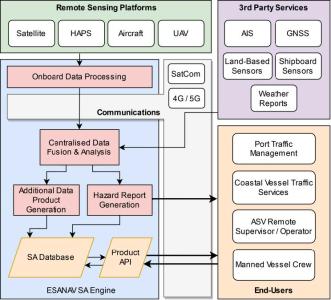Enhanced Surrounding Awareness and Navigation for Autonomous Vessels

Autonomous Surface Vessels (ASVs) are rapidly approaching market-readiness, with numerous partly-autonomous and teleoperated systems either under development or already performing operational demonstrations for applications such as bathymetric surveying (SEA-KIT Maxlimer, Deep BV), maintenance of offshore installations (Thales Halcyon), and commercial shipping (Yara Birkeland, Maersk VISTULA-Class). By reducing or removing the need for onboard crew, such ASVs offer significant advantages in terms of the automation of monotonous tasks, improved safety for operating personnel in dangerous environments, and commercial cost savings via improvements to vessel operating efficiency and the centralisation of fleet operations into a small number of shore control centres.
In order the realise the full potential of these technologies, ASVs must be capable of operating effectively and safely in either remotely controlled or fully-autonomous modes across the full cross-section of maritime environments, from crowded harbours to open sea. The completeness and accuracy of ASV Situational Awareness (SA) is currently limited by the range, resolution and close-to-sea-level perspective of shipboard sensors, in addition to the extreme diversity of potential maritime hazards (both other vessels and various non-vessel collision hazards), obscuring adverse weather conditions, in addition to incomplete or inaccurate Automatic Identification System (AIS) information. These factors, combined with both the technical and psychological barriers to remote human supervisors maintaining an adequate level of environmental awareness, and the current immaturity of ASV maritime legislation, currently limit the range of maritime environments in which ASVs are able to operate safely and effectively with a high degree of autonomy.
Furthermore, increasing rates of armed conflict, territorial disputes, sanctions, piracy and even sabotage poses in areas such as the Middle East, the Gulf of Guinea and South-East Asia constitutes a significant threat to shipping security, trade and supply chains around the globe. Additionally, cyber-attacks are a rapidly escalating concern in areas such as the Black Sea, Northern Scandinavia, the Arabian Peninsula and East Asia, but has also occurred on global scales; GNSS spoofing activities have been observed in the process of artificially shifting GNSS-derived vessel positions thousands of miles between US waters and Europe, Africa, and Indonesia, for purposes including masking illegal activity and leading unsuspecting vessels away from their intended course. All of these factors raise further concerns for the safety and security of uncrewed vessel operations, which must be addressed in parallel with the technological trend towards increasing maritime autonomy.
Developing maritime Situational Awareness (SA) capabilities to a level that facilitates safe vessel navigation and collision-avoidance in a variety of high-risk maritime environments is therefore a major enabler of commercially-viable Harbour to Harbour (H2H) autonomous operations, and the ultimate focus of the ESANAV study.
